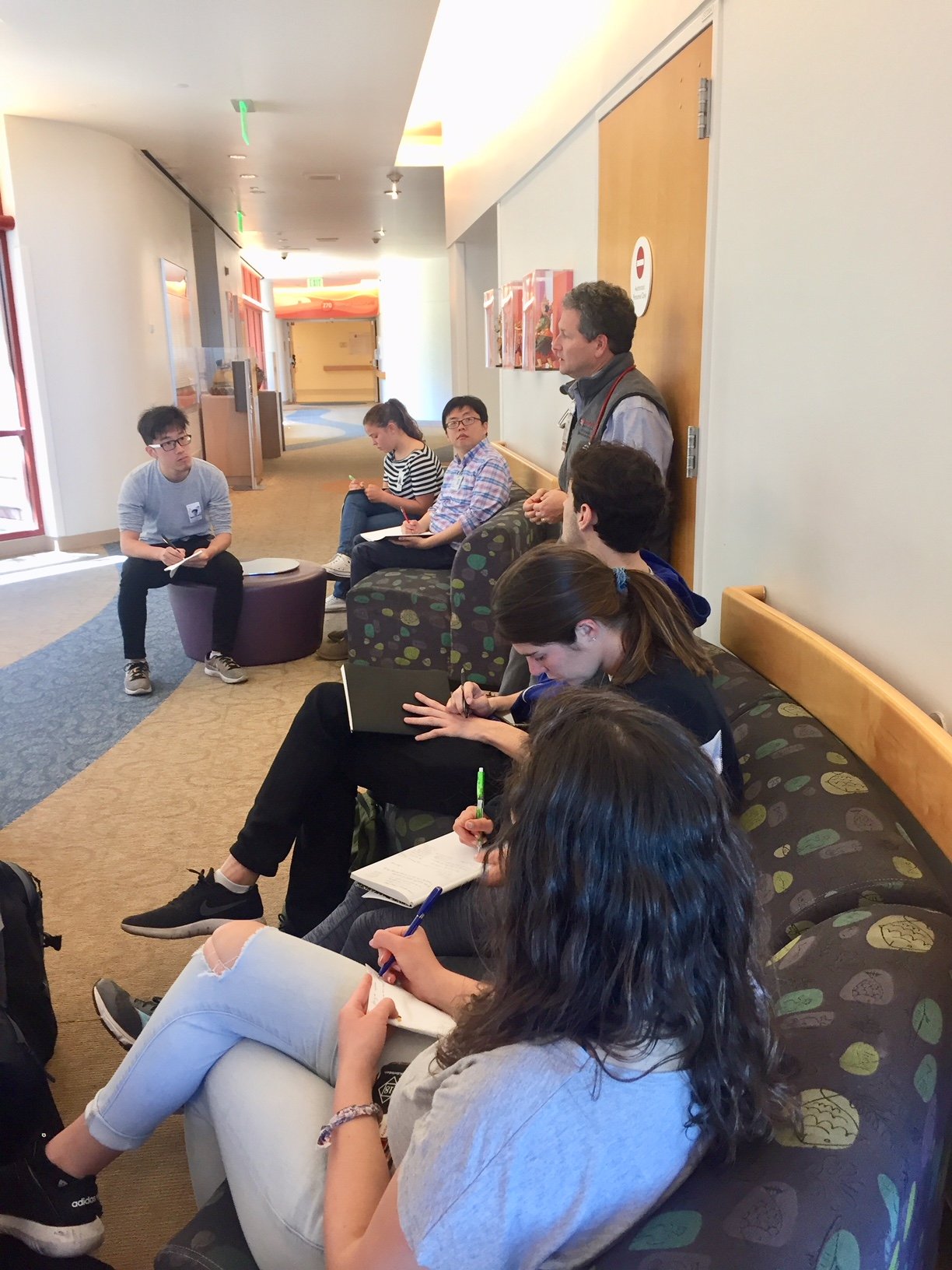Design For Child Health Equity: Redesigning Healthcare Delivery
Drawing Credit: Julia Batsheva
This post is about a d.school class I co-taught with Dr. Lee Sanders, Stanford’s Chief of General Pediatrics, called Design For Health Equity: Redesigning Healthcare Delivery.
In this class, our aim was to imagine novel interventions that may reduce health disparities for discharged NICU children with medical complexity. We focused on patients and families from low-income communities served by Stanford’s General Pediatrics Division. Our class defined and addressed “Essential Disparities” in child health, informed by national evidence and community needs assessments. We engaged Lucile Packard Children’s Hospital, clinicians, families, social service experts, policy experts, technologists and the students to imagine and redesign post-NICU care.
During the first few weeks we focus on the “understand” phase of design thinking. This phase includes a lot of reading, interviews and site visits with the various stakeholders.
The first week, students participated in a field trip to the LPCH Neonatal ICU in order to understand the challenges of that environment.
Students heard from an expert panel which included Myra Altman, PhD a post-doctoral design fellow at Stanford’s Clinical Excellence Research Center, Deb Discenza head of PreemieWorld LLC, David Bergman, MD, an associate professor at Stanford University School of Medicine and chairman of the board of the National Initiative for Children’s Healthcare Quality and is a former chairman of the American Academy of Pediatrics Committee on Quality Improvement, and Emily Whitgob, MD, MEd, a fellow in Developmental-Behavioral Pediatrics at Stanford School of Medicine.
Exert panel
Families came in to share their post NICU complex care stories. All of these families are on Medi-Cal insurance and some speak English as their second language. We are very appreciative of their participation and ability to share their stories with us.
A parent tells her story
A student wrote in her class reflection:
“Time and time again during our parent panel today, I was awestruck by the sophistication, compassion, and bravery all of our speakers demonstrated in advocating for their children’s health needs. Independent of the emotional trauma associated with having a medically complex child, I genuinely cannot comprehend the sheer organizational/intellectual challenge of navigating the tortuous healthcare, pharmaceutical, insurance, medical device, social work, education, and child care systems—all without any professional knowledge of any of these industries and sometimes even as an ESL speaker. These stakeholders have so much lived expertise that I can only barely begin to understand: managing 50 syringes worth of medication a day is just part of the lifestyle. Identifying design challenges in such complex systems that I am just starting to learn about will be challenging, which makes ethnographic research all the more important to identifying parents’ most pressing needs.”
Another student shared, “Meeting with both the families and the panelists made me so happy and overwhelmed at the same time. For the first time, I was able to really understand how critical the idea of empathy plays a role in the design process. There are so many potential areas that could have a huge impact and although each individual family is unique, I am interested in how with ethnography and human centered design you are able to solve the issues of one family or person that can be projected onto many others.” This student clearly already understands the power of designing for the extreme user. Design for this person, and the benefits will trickle down to all users.
In another student’s reflection she notes, “One comment that struck me was that there is a gap between what we know and what we are actually doing, so there are often gaps between transitions in different settings that families face, such as from hospital to home and home to school. There was also often a lack of knowledge of government and hospital systems to help navigate parents’ understanding of the financial assistance and insurance programs. Even with the help of social workers, there could be a lack of continuity between help from social workers in the NICU and social workers in the primary care clinic setting. Bridging that through more support in the home would be helpful.”
Students had the opportunity to continue their ethnographic research by visiting these families’ homes and conducting interviews in small groups. Observing a family’s context helps students see additional challenges associated with caring for a child with complex care needs. In parallel, we discussed methods for synthesis. Synthesis is a process of making meaning, and requires the ability to make decisions from a pile of data. “Problem solving is ultimately a process of decision making.” (Kolko, 2010). Sensemaking is “a motivated, continuous effort to understand connections (which can be among people, places and events) in order to anticipate their trajectories and act effectively” (Klein, Moon, & Hoffman, 2006a). Another theory is that we make meaning by doing things–such as immersing ourselves in the context of our users. In this class we are trying to assist in making those cognitive connections possible through design thinking methodology (Understand, Define, Ideate, Prototype, Test). The goal is for each student to find their own meaning, based on their background and academic pursuits. In this way, they bring a unique perspective to their project groups. Students “self-select” their project groups based on shared interests in the space and the problems they wish to solve.
Interdisciplinary design classes, such as those given at Stanford’s d.school, are reflective of the professional world where one must navigate ambiguity and synthesize information with people from various walks of life. In order to collaborate effectively with people from different backgrounds we must come to design with both empathy for our users and for our classmates.
References:
Exposing The Magic of Design: A Practitioner’s Guide to the Methods and Theory of Synthesis, Jon Kolko 2010
Making Sense of Sensemaking 1: Alternative Perspectives Gary Klein, Brian Moon, and Robert R. Hoffman Vol. 21, No. 4 July/August 2006






